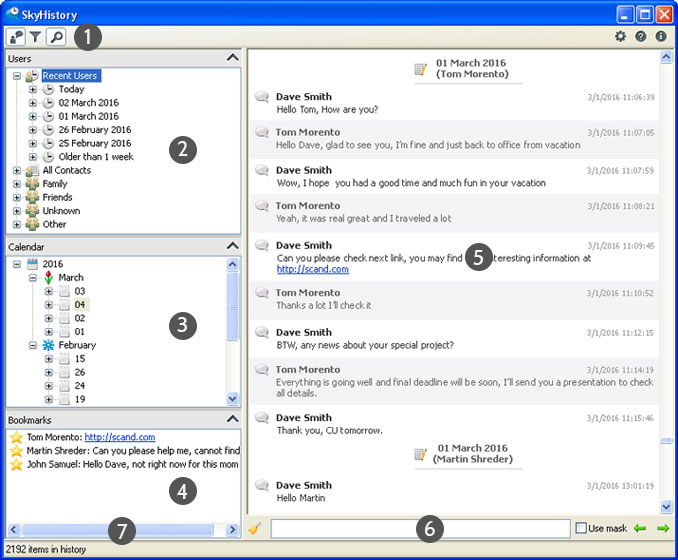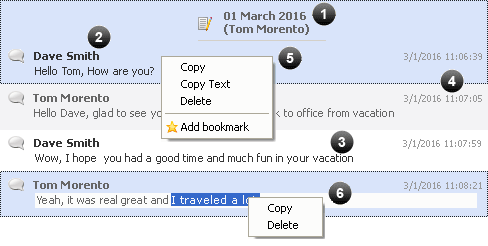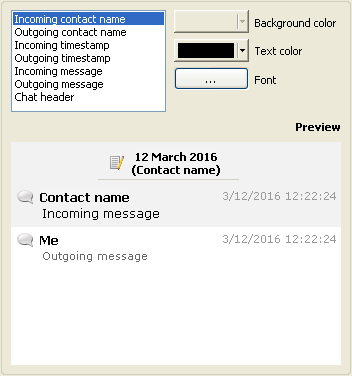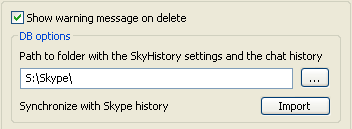SkyHistory is one of the most efficient Skype chat history viewers. The functionality provided by the free version of SkyHistory implies searching through Skype chats chronologically and by Skype username. The commercial version gives you an opportunity to bookmark any chat line in your Skype message archive and also enable filtering and the use of a search bar. It’s easy to start SkyHistory on your device because the installation wizard will guide you through the whole setup process.

- Buttons.
- User Bar.
- Calendar Bar.
- Bookmark Bar.
- Chat History Window.
- Search/Filter Bar.
- Status Bar.
Navigation Bars
User Bar

The window contains the imported Skype contacts that are divided into 4 types.
- Recent Users
This group includes all contacts you have recently been chatting to. The contacts are filtered timewise and the recent communications are showed prior to the rest: - All Contacts
This group includes all Skype contacts; - User Defined Groups
The contacts from this group are directly imported from the Skype user defined groups. All the groups created originally will be reflected in the User Bar. - Ungrouped
These are the contacts that have not been categorized by the user yet.
Calendar

Bookmarks

This section is used to store messages that have been bookmarked. This option is enabled only for the commercial version of SkyHistory. A free version doesn’t support bookmarking.The messages are marked with the help of Add bookmark option. All the bookmarks are stored in the appropriate history window. The title of the bookmark is made up by the contact’s name and the first couple of words from the message string. The total length of the text to be shown up as the bookmark is 50 characters max.
Chat History Window

The Chat History Window contains all the chat messages. Every chat is separated and isolated in its own block. The messages in the chat are grouped by time (from older to newer ones).
- Chat header. Includes the chat start date. The contacts that participated in the chat are provided in the brackets.
- Contact name. There could be three variants of how the contact name is displayed:
- “Display name” the Skype account name given by the user;
- “Contact name” the account name indicated in the profile;
- “Skype name” the login name.
The Chat History Window is configured to show ‘Display name’ first. If it’s unavailable the ‘Contact name’ is displayed. In the case when the latter one is also not provided ‘Skype name’ is used.
- Message text.
- The date and the time when the message was sent. Regional settings are applied.
- Select the required message and its context menu.The following options are available in the context menu:
- ‘Copy‘ option allows to copy the message together with the sender’s name, date and time:
Dave Smith, 3/1/2016 11:06:39: Hello Tom, How are you? - ‘Copy text‘ option is designed to copy the text of the message only: Hello Tom, How are you?
- ‘Delete‘ option is used to delete the selected messages.
- ‘Add bookmark‘ option allows to add the message to the Bookmarks pane.
- ‘Copy‘ option allows to copy the message together with the sender’s name, date and time:
- This bar is used to copy the massage fragment or delete the selected message by using the context menu. There are two ways to start: 1) double-click on the message; 2) select the message and hit ‘Enter’. This mode does not allow editing messages in the active SkyHistory window.
To navigate the Chat History Window the following keys can be used as well:
- Up and Down arrows to go across the messages;
- PgUp and PgDn keys to control scrolling;
- Enter sets the selected chat message into the edit mode;
- Esc sets the selected chat message into the read mode.
Search
Searching enables the user to find the message that meets the search criteria defined in the search box.
To find a message one can use the key words or the signs like “?” or “*”. The signs are applied only if the checkbox “Use Mask” ![]() is checked, otherwise the special symbols “?” or “*” will be treated as common characters.
is checked, otherwise the special symbols “?” or “*” will be treated as common characters.
To go through older or newer messages right and left arrows ![]()
![]() are used.
are used.
To clear/reset the search criteria use the following ![]() button.
button.
Filter
Filtering allows the user to show the messages that meet the specific criteria defined in the filter box.
As a filter one can use the key words or the signs like ? or *. The wildcards are applied only if the checkbox Use Mask ![]() is checked, otherwise the special symbols ? or * will be treated as common characters.
is checked, otherwise the special symbols ? or * will be treated as common characters.
To clear/reset the search criteria use the ![]() button.
button.
Clear the History
There are three ways to delete a message:
 The first way is to select a message you want to delete in the chat history window and use the “Delete” option in the context menu;
The first way is to select a message you want to delete in the chat history window and use the “Delete” option in the context menu; The second way is to select one of nodes in the Calendar Bar, using the ‘Delete’ option in the context menu and delete all conversations related to the selected node;
The second way is to select one of nodes in the Calendar Bar, using the ‘Delete’ option in the context menu and delete all conversations related to the selected node; The third way is to select one of nodes in the User Bar and, using ‘Clear History’ option in the context menu, delete all conversations related to the selected node.
The third way is to select one of nodes in the User Bar and, using ‘Clear History’ option in the context menu, delete all conversations related to the selected node.
Configuration and Options
Grid Setting

This page allows the user to configure the way messages are displayed in the Chat History Window. They can be customized in the following ways:
- Skype name for incoming messages (font and text color);
- Skype name for outgoing messages (font and text color);
- Time and date of incoming messages (font and text color);
- Time and date of outgoing messages (font and text color);
- Incoming message (font and text color, background color);
- Outgoing message (font and text color, background color);
- Chat header (font and text color, background color).
DataBase Location and Import

This page contains the chat history database settings that can be customized.It is possible to:
- Define whether a warning message will be displayed or not each time when a message is deleted from the database;
- Select a path to the folder containing the application configuration files and the chat history database;
- Import the existing messages from Skype if you have just installed SkyHistory;
- Update your message database if you have already imported your message history earlier. In this case SkyHistory compares the chat history in Skype and in the SkyHistory database and updates its database with the missing messages.
Security

Useful things you can do to adjust the layout
Resize the main window by dragging window corners ![]() to make the window bigger or smaller.
to make the window bigger or smaller.
Resize the bars and message history windows horizontally by dragging the vertical splitter ![]() between the bars section and the history window to make them wider or narrower.
between the bars section and the history window to make them wider or narrower.
Resize the “Users”, “Calendar”, “Bookmarks” panes vertically by dragging the horizontal splitter ![]() below or above the necessary bar to make them higher or lower.
below or above the necessary bar to make them higher or lower.
Show/hide the “Users”, “Calendar”, “Bookmarks” bars by clicking on the ![]() button in the caption of the required bar to hide and the
button in the caption of the required bar to hide and the ![]() button to show it again.
button to show it again.
The Button bar
![]()
| Show/Hide the “Navigation” panel (CTRL+N) | |
| Show/Hide the “Filter” panel (CTRL+F) | |
| Show/Hide the “Search” panel (CTRL+S) | |
| Show the “Options” dialog (CTRL+O) | |
| Show help file (F1) | |
| Show the “About” dialog (CTRL+?) |
Status bar
The total number of messages and conversations that meet the search criteria is displayed.
![]()
Keyboard layout
| F1 | Show help file |
| ALT+? | Show the “About” dialog |
| CTRL+F | Show/Hide the “Filter” panel |
| CTRL+N | Show/Hide the “Navigation” panel |
| CTRL+O | Show the “Options” dialog |
| CTRL+S | Show/Hide the “Search” panel |
| CTRL+Q | Quit the application |
